Batman TAS: 4 Ways to Rework a Mythos
Batman The Animated Series has been named one of the top animated programs of all time, on numerous occasions. It garnered four Emmy awards including, Outstanding Animation Program. In 2013 TV Guide named it as the seventh Greatest TV Cartoon of All time. A title hard-earned by creators who not only understood how to tell a good story, but how to tell a good Batman story. BTAS created a whole new cast of characters such as Harley Quinn, the Phantasm, and Baby Doll. It reinvented some old characters such as Mister Freeze and Two-Face. Most importantly, it created a Batman rich with personality and tragedy.
Batman The Animated Series manages to be inventive without completely uprooting the traits and stories that were instrumental in its mythos. The series is character driven, thematically complex, inventive, and artistically competent. The series aired from 1992 to 1998 running for four seasons with several movies in between. For a series to last so long, the creators have to establish one mythos, and this can be hard if they are adapting from an already established one. The creators over at BTAS knew how to rework a mythos to suit their needs, here’s how.
1. Make the Hero Interesting
Batman is unquestionably a dark character, a creature of vengeance. In fact, one of his most iconic lines in the show is “I am vengeance.” BTAS was intended to be a family show, both kids and adults could watch together. So obviously they couldn’t get too dark, or go too far. For example they couldn’t show death or realistic violence. However, the roots of the character, a little boy lost, a boy seeking vengeance, is a prominent feature. Neither his psychological complexity nor his tragedy are forgotten or pushed aside to make it more “family oriented.” One shining example of this in the episode entitled “Perchance to Dream.” In this episode, Bruce Wayne wakes up to find his parents alive, as if the night in the alley never happened. He’s engaged to marry Selina Kyle. There are no remnants of the life he had before: no bat cave, no bat suit, nothing. Bruce is perfectly content to live the life he should have lived, that is until a different “Batman” shows up.
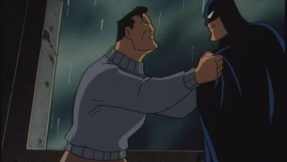
Convinced there is someone impersonating him, he tries to tell Selina about his previous life. Bruce starts seeing a psychiatrist who believes Bruce has created this batman persona to make up for his cushy life style. After all a billionaire does not have hard life. The psychiatrist believes giving money to charity is not enough for his subconscious, so he had to make up an identity that would make a real difference in society. It is soon revealed that this world is just a dream created by the Mad Hatter, who just wanted Batman to leave him alone. After all it was Batman who ruined Jervis Tech’s dream to be with Alice, thus creating the Mad Hatter persona. In this episode we are given just one of the possible reasons Bruce Wayne became Batman. It is not dumbed down in any way or pushed to the side. The writers had faith that children are capable of understanding why someone would like to pretend to be someone else. And adults can delve deeper into Bruce’s complex psyche.
Another interesting choice for Bruce was to allow him to be caring while in the Bruce Wayne persona, particularly in the episode “Forgotten.” Usually, in Batman media the Bruce Wayne personality is shown to be incompetent playboy. Indeed, the playboy angle is certainly there but Bruce is shown to be just as caring in and out of the cowl. For example, in “Forgotten” Bruce Wayne loses his memory after going under cover as a homeless man. While undercover not as Bruce, not as Batman, but as some homeless man, he’s smacked on the back of his head and forgets his life as a billionaire playboy. This episode we see Bruce as just another man, not a vigilante, not a billionaire, but just a regular guy. Bruce the billionaire does charity work. Bruce the homeless man does real work. Batman went undercover to find several missing men. He finds the men shortly after losing his memory, but does not remember he went searching for them. Bruce is seen caring for the men as equals, even remembering them long after he gets his memory back. Bruce is not the only character who gets the proper treatment, his villains get just as much spotlight.
2. Make the Origin Story Matter
BTAS features many episodes focusing on the origins of many villains. It has all the mainstays of the Batman universe like Joker, Two-Face, Poison Ivy, and Penguin. Two-Face in particular got a very well planned out origin. In keeping with comic book tradition Two-Face was once Harvey Dent, the Gotham District Attorney. Instead of just introducing Two-Face without any real background, the show spends a good time getting to know Harvey Dent. When we first meet Dent we discover he’s a good friends with Bruce Wayne and is dedicated in making Gotham City a safer place. He trusts Bruce and even goes so far as to ask him for dating advice when he finds himself enchanted by Poison Ivy.
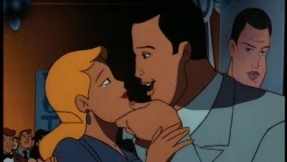
It isn’t until later that we are introduced to Dent’s alter ego “Big Bad Harvey”. It seems “Big Bad Harvey” has been harder to control as of late. Witnessing Dent’s latest outburst, Mobster Rupert Thorn sets out to destroy him. He blackmails Dent, and tells him he’ll release the info about his second personality to the press unless, Dent promises to leave the mob alone. Soon Dent, Batman, and Thorn all find themselves at a chemical plant where an explosion results in Dent’s disfiguration. In the BTAS, Dent has a fiancée whom he is in deeply in love with. Their separation after his disfigurement is handled in a touching way. Harvey reaches out to her and only her in his time of desperation. Despite his face his fiancé still wants to be with him. Unfortunately, Dent believes he would only hurt her, now that Big Bad Harvey is becoming the dominant personality. Their relationship makes his fall all the more tragic as we see he will not only be missed by his good friend Bruce but his fiancée too. However, its Mister Freeze of all people, who gets the most heart breaking origin of all.
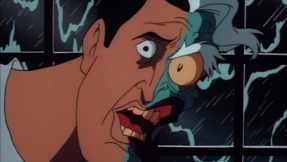
Before the episode “Heart of Ice” Mister Freeze did not have an origin. He was just guy in blue who crafted a freeze gun. In “Heart of Ice” we learn that Victor Fries was a scientist working at GothCorp who got mixed up with the wrong guy at the wrong time. Fries was researching cryogenics and froze his terminally ill wife, Nora, until the time a cure for her condition could be found. Fries tells Batman he dreamed of time where he could hold her warm hand in the sun, and how that dream is now destroyed by CEO Ferris Boyle. Boyle pulled the funding of Fries’ research which would result in killing Nora. When Fries attempts to stop Boyle he gets thrown in cryogenic chemicals resulting in his inability to survive in above freezing temperatures. Fries becomes Mister Freeze and seeks vengeance upon Boyle who made it impossible for him to be with his wife ever again.
The writer of this episode, Paul Dini, says when it came to inventing an origin for the character he felt someone so cold had to be cold for a reason. His new origin was so widely acclaimed that it had been reconnected in comics and even was used in Joel Schumacher’s Batman and Robin. This episode is an excellent example into why this series is so beloved by fans. The creators went back to the roots of each character and rebuilt them to suit a modern audience, while still retaining that which made us fall in love with the characters in the first place.
3. Introduce New Characters
There is a saying at DC that every time you reintroduce an old character you introduce a new one. In BTAS they introduced a few characters that have made their way into the comics’ continuity. The most notable one being Harley Quinn, a former psychiatrist turned villain, after falling in love with the Joker. Other examples of new characters include Baby Doll and the Phantasm, both villains.
Mary Dahl, a former child star, turns to insanity after failing to resuscitate her career. Dahl has a genetic disorder that prevents her from ever physically growing to womanhood, because of this no one can see her beyond her childhood role as Baby Doll. After several attempts to be seen in a different light, Dahl is forced into obscurity. She begins to believe that she was wronged by the world and seeks vengeance. Dahl kidnaps her former cast mates to recreate her golden years as a childhood star. Following this, Dahl attempts to blow up her former co-stars with a cake topped with dynamite and other explosives. Robin saves the cast mates while Batman pursues Dahl. This episode manages to be creepy but also keeps the pathos we need for us to care about Baby Doll. At the end of the episode when Batman is chasing Baby Doll in a fun house, she sees herself in a fun house mirror. She sees the person she could have been, an adult woman. She then begins to break down and mutters her signature line from her Baby Doll days, “I didn’t mean to.”
Andrea Beaumont, a former girlfriend of Bruce Wayne, becomes the Phantasm. A ghoul like being that seeks vengeance for losing her father to the mob. The two fell in love many years ago, when Batman was just an idea in Bruce’s head. The two of them bond over lost loved ones and find they have a lot in common. She makes her debut in the feature film The Mask of Phantasm. She is created as a foil to Batman. Both have tragically lost a parent and both seek to undo the wrong. Andrea Beaumont, the girlfriend, seeks vengeance by killing. While Batman seeks vengeance by ensuring no one has to lose what he has lost. These two different philosophies clash spectacularly in the climax of the film. “I lost everything Bruce. Look what we could have had.” Batman responds with “But what would vengeance solve?” The character was so well received that she was carried on into the Batman Beyond (the sequel to BTAS) universe.
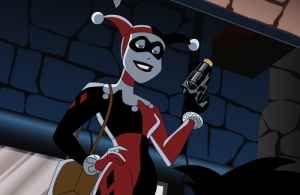
Most notably BTAS is where Harleen Quinzel also known as Harley Quinn, made her debut. Meant to be just a walk on role she skyrocketed into a fan favorite. Harley is a bit of a chameleon in the show. Sometimes a villain, sometimes helping out the good guys, Harley remains a main stay in the DC Universe. She’s goofy, murderous, giddy like a school girl, and fully capable of putting the hurt on if her puddin’ demands it. She fell in love with the Joker after treating him at Akharm Asylum. She saw him as a lost soul and believed it was the self-righteous Batman that caused him to turn to the dark side. Harleen decides to don white face paint and a jester like costume to be the perfect complement to the love of her life. Naturally, the Joker isn’t capable of loving anyone and abuses her. No matter how bad he treats her she sticks around, making her a relatable but tragic character.
4. Tell the Story Visually
BTAS is also well-known for its art style which has been dubbed dark deco, a combination of both art deco and film noir style. Art deco is an art style that flourished in France after World War I. The style is often characterized by rich colors, bold shapes, and lavish decoration. Machinery is often a motif in art deco. Film noir on the other hand, is a genre of film that came to prominence during World War II. The classic film noir is hardboiled detective story and there is heavy use of shadow and shading in the cinematography. Both these art styles inspired the animators and designers of BTAS. The animators were instructed to create on dark backgrounds, which forced them to use light colors on everything else, contributing to a more moody look. The creator of this look was producer Eric Radomski. Writer Paul Dini said it was a world where technology like computers and television could exist but the stylish era of 1939 would still be present.
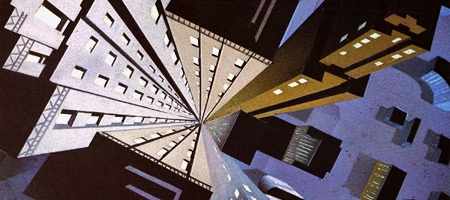
Batman The Animated Series successfully reinvented characters like Two Face and Mister Freeze. It created new characters like Harley Quinn, Baby Doll and Andrea Beaumont that belonged in the world. It made Batman lovable again, while respecting the source material. As the time changes characters must change with them. And the worlds they inhabit must follow suit. The creators of BTAS understood this and so they carefully built a show around these reinvented characters and their world. They invented a new mythos that could still exist in one already established. So future TV writers take note, this is how you adapt a beloved series.
What do you think? Leave a comment.


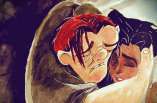








Seen all the movies, and just about every other animated version of the character and I still think this is the best interpretation of Batman I’ve ever seen.
While it is true that the animation is a bit dated and some of the dialogue is a little clunky now I still think this holds up fairly well. It did well with the characters it had and even added something more to some of them( like Two-Face and who can forget the creation of Harley Quinn or The Phantasm?), and the voice actors were appropriately chosen( Especially Mark Hamill as The Joker and Adrienne Barbeau as Catwoman). This show was also able to appeal to all sorts of fans of the character and pay respects to all versions of the character prior. It raised the bar for Saturday Morning Cartoons for it’s complexity and edge.
The only thing I can’t say I liked looking back at it and re-watching it on The Hub is the exclusion of Jason Todd and the treatment of Bane, still I’ve gotta say that I don’t think any of the Nolan films, video games, or recent Batman-related television shows have ever come to touching this show, although I admit it’s not totally fair to compare different mediums although it is all Batman by the end of the day.
My biggest complaint — the design of Batman from those first 65 episodes was not carried over to “Superman: The Animated Series” and “Justice League” when Batman appeared. I hate those big, sideways sticking ears from the “Justice League”; I also hate that the edge was taken off his look and acting on the show. He still had a tad of it at times, but not enough.
I really like Nolan’s trilogy of films, though they do deviate in a number of ways. I guess that is going to happen when you are restricted to the confines of movies.
Being an animated series like this, they had the time to truly explore the characters and get things right. Their changes were usually always for the better and actually added to the mythology of this universe rather than distracting from it.
The definitive Batman for me.
I like it up till the Dick Grayson eps then the animation sucks compared the older eps
One thing I don’t like about the cartoon was it’s ridiculousness. I was watching an overall good one last night when the Joker captures comedians and brainwashes them to do crimes. He throws a laughing gas grenade in the crowd, Batman throws a batarang hits the grenade(Yeah right!! He has a helluva aim), and the grenade richochette’s(sp) off the batarang and goes out the window. What in the world???!!! Great episode overall, though.
I almost forgot that Harley was first introduced in TAS. We can only hope that if a new one is made we get equally as amazing characters to root for or hate.
As a fan of the Batman and am aware of just about ever incarnation out there comics, animation, live action tv and movies, I can say that yes this version *is* the best. I *love* the way Bane was handeled.
Really? I thought Bane was handled quite badly in this. He was just another random henchman, nothing special. He only posed a thread in Over The Edge but it was all a dream, it never happened.
Bane in the comics was a cold, calculating genius who pushed Batman both physically and mentally. He even deduced his identity by observing the way Wayne walked at a party. He was handled only a little better in The Dark Knight Rises but his venom was taken away, although he could still punch through walls, and was still a lapdog at the end of it all.
Well, at least The Riddler had a good voice, Bane to me never sounded right. In his first appearance he sounded a little more comical than menacing to me, then in the revamp he sounded too much of a thug with little intelligence.
BTAS and Nolan’s movies are the best Batmans for me.
It had 85 episodes to cement itself as the best, but it is clear from the first few shows that it is just incredible. And as an extension of that I’d say Mask of the Phantasm is the best Batman movie. I don’t really dislike any of the movies I’ve seen, though Nolan’s fanboys exhausted me so on his series that I still haven’t bothered with seeing TDKR. They all have their merits (yes, even Batman & Robin…) so it isn’t like it is Usain Bolt winning a five-yard dash in the Special Olympics. It is a big deal for it to be tops.
BTAS was flawless and has yet to be matched, and it won’t be.
I’m starting to watch the Animated series here again for the first time since it first aired, really, and seeing now as a 27 yr old as opposed to a 8 or 9 year old, you can see how ridiculous it is.
I was watching one last night called Zatanna, or something about a magician that Bruce used to know, and they were stuck in a room where the wall with spikes was closing in on him and her. He whips out acid or something, and melts a couple spikes off to jam under one of the doors to stop it and pry open the ceiling with the other. Since when does Batman carry acid in his utility belt??? They should have died, or he shouls have had a batbomb or something. Whipping out acid was ridiculous. Or the one where the Riddler has him and Robin in a Minataur maze, where Batman had like a computer in his glove hat could control the giant hand of fate if rewired. Since when does Batman have a computer in his glove??? The writers just think of conveinant plot devices to get Batman out of ANY situation.
All this being said, I still think it’s a great cartoon, just lame how they come up with all this stuff to get him out of these situations.
I just watched that episode the other day. I thought it was pretty creative how he used acid to stop that wall of spikes, and then used the spikes to climb out. But I was thinking, why didn’t he just use the acid on the other wall, to make that one stop as well?
I don’t know, this show is too badass overall to even notice silly details. But it was a Cartoon Network show based off a comic book, there will be some ridiculous moments.
Batman has virtually everything in his utility belt.
My top 10 favorite episodes are:
1.Dreams in darkness(in this moment,my personal favorite,great,great,great episode
2.Almost got ‘im
3.Old wounds
4.Over the edge
5.The man who killed Batman
6.The Strange secret of Bruce Wayne
7.Nothing to fear
8.If You’re So Smart, Why Aren’t You Rich?
9.Shadow of the Bat
10.Trial
Just started re-watching the series, and so far, I’ve liked ‘Heart of Ice’ the most.
My favourite episode has got to be ‘Heart of Ice’. Even as a kid that episode in particular left an impression on me. I remember that The Cat and the Claw Parts 1 and 2 were the first episodes that I saw of the show (on VHS) but when I saw Heart of Ice on Cartoon Network I just fell in love with the series completely and would never miss a re-run of the show.
I remember the first episode I caught a glimpse of the series was one of the last episodes of the original Batman TAS back in 1995 when I was 5 years old. It was ‘Second Chance’ – that made me wanna watch Batman Forever at the cinemas haha! And then the following year was when I properly sat down and watched the animated series, both on VHS cassettes and on Cartoon Network.
Anyway like I said….’Heart of Ice’…
Thank you Cagney for this great foundation of BTAS I learned some new things.
One of the most difficult tasks in adapting a story, especially one as well-known as Batman’s, is in getting the balance right between fidelity and originality. I think you’ve done a good job of explaining how Batman TAS managed this perfectly and how this contributed to its overall (very high) quality.
Great look into what I consider Batman. From compelling stories while dark yet family friendly to the use of “dark” deco made this a standard of Batman.
I love almost every episode from this series, but my absolute favorite is “Two-Face” part 1-2. It not only has beautiful animation, but a fascinating character study of a man with a Jekyll and Hyde complex. I forgot that this episode was the first time Two-Face was explored to the fullest for his character.
I agree with the above comments on the first episodes of Batman T. A. S. being the best of this show, both story-wise and artistically speaking as well as a person who grew up watching the series. The two episodes on Harvey Dent’s descent into villainy were particularly bold in their themes of psychology with Harvey’s repressed anger resulting in his split personality as Two-Face. Not only is that aspect uncomfortably possible in real life, it is also taken seriously with no light-hearted gags to distract from the character’s tragedy as how lesser animated shows might’ve handled it.
And the take of Harvery Dent as a tragic villain is further amplified by the animation itself with some of the most realistic fleshy character depictions offered by Batman T.A.S. with graphic depictions of Harvey’s mental breakdown and subsequent facial scarring (while still keeping the E rating intact, however much it may have been pushed). So that in itself easily makes the two-parter episodes for Harvey Dent a memorable example; this series valued the emotions and intelligence of all its viewers in a way few shows would dare and the article conveys that quality well.
There does seem to be a certain depth of characters here.